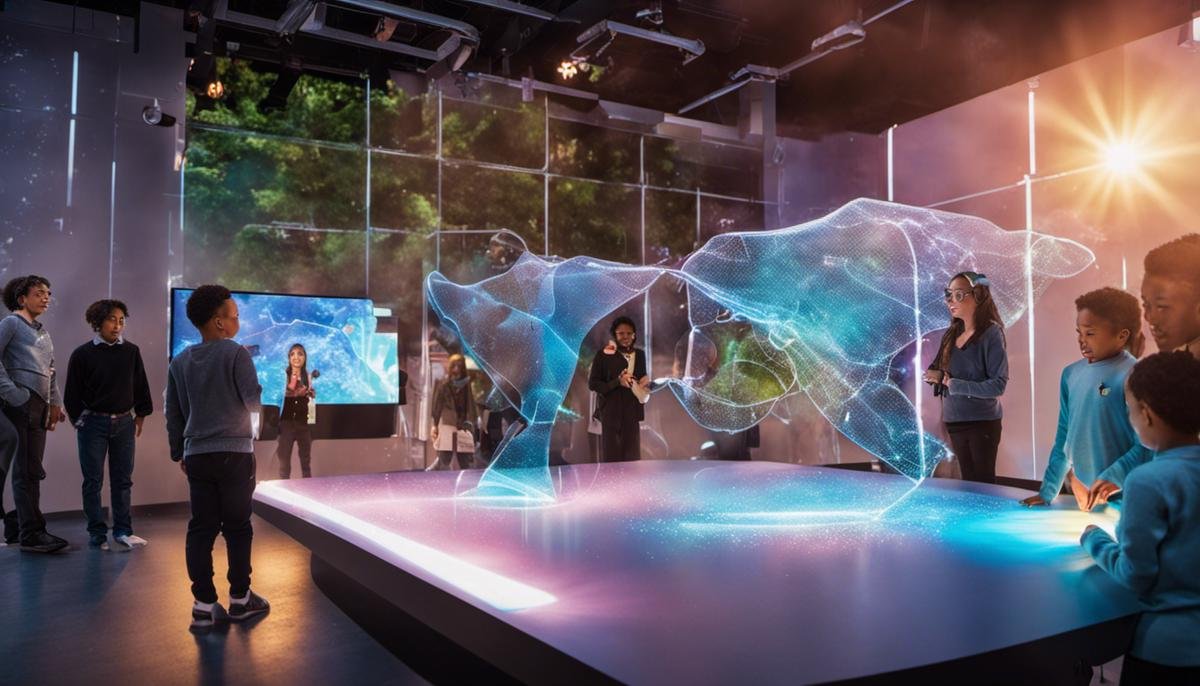
The intersection of technology and Autism is a dynamic and evolving area that presents a myriad of opportunities to improve the lives of those impacted by this disorder. Autism, characterized by unique challenges, presents an enduring call to the tech industry in working towards innovative solutions. Delving into this confluence, there is a clear need to address how technology has been instrumental in augmenting communication, education, and social skills among Autistic individuals. The following discussion takes note of cutting-edge devices aiding communication, the role of assistive tech in honing learning capabilities, progressing trends in social interaction tech, and the future direction of tech innovations catering to Autism.
Overview of Autism and Technology
Technology: A Transformational Tool in Addressing Autism Challenges?
Autism Spectrum Disorder (ASD) often presents unique challenges that can be taxing for individuals and their caregivers. From communication hurdles to social skills deficiencies, autism continually necessitates intelligent solutions. But there’s a shining beacon of hope firmly planted in the tech world- Technology, a path-breaker, trailblazing through these challenges with remarkable potential.
The advent of assistive technology has modified the landscape for individuals living with ASD, featuring an array of tools designed specifically to cater to their needs. Featuring everything from apps and software to hardware and specific devices, this tech innovation spectrum is expansive.
Voice Recognition Software is revolutionizing the way children with autism communicate. The likes of Amazon’s Alexa and Google’s Assistant are not just virtual assistants but catalytic aids that assist in enhancing speech recognition and interaction abilities. Responding to queries, giving prompts, and helping in language learning, these AI-based systems are bridging the gap in communication.
There are innovative apps that transform smartphones and tablets into handy tools that facilitate language acquisition and social skills development. A standout example is Proloquo2Go, an augmentative and alternative communication (AAC) application. It transforms symbols into clear speech and is full of customization options, promoting language development and communication for non-verbal individuals with autism.
Robotics is another arena where technology is making significant strides in terms of autism therapy. Interactive robots designed to assist children with autism in developing social and emotional skills are a dazzling revelation. Robots4Autism’s Milo, for example, teaches ASD learners to tune-in on emotions, express empathy, act more appropriately in social situations, and self-motivate.
Biofeedback devices like the EmWave system help people with ASD manage stress and anxiety, common occurrences in the autism spectrum. These devices provide visual or auditory feedback about physiological responses like heart rate and skin temperature, enabling users to self-regulate their emotional states.
Virtual reality offers immersive experiences to ASD individuals, a chance to practice their skills in a controlled environment. From routine activities to social interaction, these VR platforms are becoming a secure space to learn and grow.
Wearable technology, like smartwatches that monitor physiological cues such as heart rate, can alert caregivers or the wearer themselves when anxiety or a potential meltdown is imminent. This gives them the opportunity to initiate calming strategies or preventive measures promptly.
The integration of machine learning and predictive analytics into care for individuals with ASD also offers an opportunity for more personalized therapeutics. By analyzing patterns and correlations in behavior, tech can enable anticipation of challenges and proactive strategy development.
All these burgeoning technologies are pioneering change, leveraging potential to lend a helping hand to those negotiating life with autism. Each stride, each innovation unravels a world of opportunities and accelerates progress towards overcoming autism’s trials. Technology, thus, emerges as a modern-day hero, challenging the challenges posed by autism.

Innovative Devices for Communication
Cutting Edge Technology Innovations Empowering Individuals with Autism
The technological landscape is evolving at an impressive pace, and it’s providing some extraordinary benefits for individuals with Autism Spectrum Disorder (ASD). Beyond the assistive technology and voice recognition software, several radical innovations are pushing the boundaries, redefining the way we communicate and interact. Quietly, yet steadily, they are enhancing lives, fostering independence, and boosting essential social skills among these individuals.
One of those revolutionary advancements is Augmented Reality (AR). Akin to its cousin VR, AR offers a safe and controlled simulated environment, where users can practice essential life skills. AR overlays graphics on the physical world, transforming an ordinary environment into an interactive playground. An example of this is the AR application “Brain Power’s Empowered Brain”, which uses game-like themes to improve social skills and foster emotional self-regulation capabilities in individuals with ASD.
Artificial Intelligence (AI) is another trailblazing innovation vastly improving autism therapy. Specific AI-driven tools offer real-time facial recognition which can interpret and teach emotional cues to children on the autism spectrum. Such a tool is helping these children connect and interact more effectively with their social environment. An example of this in use is Affectiva’s Emotion AI, which recognizes and interprets human emotional signals.
Stepping into the world of holography, Hologram-assisted Learning is another innovation enabling transformation in the autism therapeutic landscape. Holograms of real people can be used to teach social skills in a controlled, repeatable, and interactive manner. Holograms also provide a means for individuals with autism to practice social situations without the pressures of in-person interaction.
While these technologies tackle the hindrances in social interaction and communication, other innovation trends are focusing on improving the individual’s day-to-day management. For instance, the introduction of Smart Homes utilizing IoT (Internet of Things) is proving to be a game-changer. These “connected homes” allow the setup of routines, reminders, security systems, and tracking devices that cater specifically to the needs of ASD individuals. Automated routines can help reduce anxiety related to unpredictability, promoting a sense of security and independence.
On the horizon, we’re looking at the potential integrations of Blockchain technology in managing the individual health data for personalized therapeutic approaches. Blockchain could provide secure ways to manage and exchange health information, paving the way toward more personalized and effective therapeutic interventions for autism.
An ocean of opportunities is unfolding with these technological advancements for people with ASD. The intersection of disability and technology no longer merely suggests functional assistance. Today, it embodies empowerment, fostering growth for individuals with autism in their journey towards better communication and more independent lives. Unquestionably, these advancements will continue to evolve, and with them, opportunities for individuals with ASD will proliferate further.
And in this revolution, everyone – researchers, developers, therapists, caregivers, and individuals with autism themselves – has a crucial part to play for this extraordinary fusion of technology and humanity to reach its fullest potential.

Assistive Tech for Learning & Education
Studying the landscape of autism education gives us remarkable insights into how the most advanced technology is empowering individuals to surpass their challenges. Harnessing these advancements to complement traditional therapy techniques allows us to amplify results, illustrating just how instrumental technology is in autism education.
Augmented Reality (AR) is among the recent groundbreaking innovations that are revolutionizing the realm of autism education. By merging digital information with the user’s physical environment, AR fosters social skill enhancement and emotional self-regulation. Autonomous AR activities can provide a safe and controlled environment where an individual with autism can develop expertise in comprehending strategies for different interpersonal scenarios and managing their own emotional responses.
On another front, we see technology using Artificial Intelligence (AI) and facial recognition to decipher and teach emotional cues. Taking input from real-time facial expressions, these AI-powered solutions offer immediate feedback for emotional identification, which is a persistent hurdle for many on the autism spectrum.
A fascinating emergence in this tech-influenced landscape is hologram-assisted learning. By manipulating holographic models and utilizing interactive simulations, individuals with autism can practice and perfect their social skills in a stress-free, immersive environment.
As we delve deeper into everyday life, the Internet of Things (IoT) has the capacity to transform ordinary households into smart homes. For individuals with autism, this offers promising support in managing daily routines and activities, providing reminders for tasks, schedules, and even health requirements.
The profound potential of Blockchain technology cannot be overlooked. Its decentralized, secure, and transparent nature can be leveraged to personalize therapeutic approaches. By storing and analyzing an individual’s data, Blockchain can aid in crafting customized therapies, learning plans, and behavioral strategies.
In the midst of these remarkable breakthroughs, it becomes increasingly clear that technology serves to foster empowerment and growth for individuals with autism. The capacity to learn at their own pace, in a structured and supportive environment provided by these advanced technologies, grants unprecedented avenues for independence and productivity.
Yet, implementing these technological solutions requires concerted efforts from all stakeholders – researchers developing accurate and ethical tools, therapists integrating these tools within traditional therapy frameworks, caregivers adapting to new techniques, and individuals with autism fearlessly embracing these new opportunities.
The future of autism education, inextricably intertwined with cutting-edge technology, holds immense promise. As enthusiasts of tech, it’s our role to advocate for these advancements, ensuring these spectacular tools continue to change the lives of those with autism for the better. As we move forward, these integrations will only continue to revolutionize how we understand, approach, and ultimately, empower individuals with autism. Technology, in this realm, proves to be a tremendously valuable ally.

Social Interaction Tech for Autism
Shaping the Future of Autism Education: Diving Deeper Into Technology Integration
There’s no doubt that technology is drastically innovating education and therapy techniques for individuals with autism. However, to get a clear view of the instrumental role technology can play, it’s crucial to go beyond the highlights of augmented reality, artificial intelligence, hologram-assisted learning, and smart homes. Delving deeper, we find cutting-edge tools such as brain-computer interfaces(BCI) and big data opening up new horizons for autism education and empowerment.
BCIs represent a groundbreaking advancement in interfacing technology with neurological conditions. Through direct communication between the brain and a device, BCIs hold potential for individuals with autism to articulate their thoughts and preferences in a new way. They are primarily used to aid in communication, mobility, and mental state regulation – three areas often challenging for autistic individuals. By bypassing traditional communication pathways, BCIs could revolutionize interaction and engagement for those with autism.
Similarly, the rise of big data could greatly impact autism education and empowerment. By compiling vast datasets from diverse sources – including genetics, environmental factors, educational strategies, and social influences – researchers can identify patterns and trends that may not be visible on a smaller scale. This concept anchors on predictive analytics driving personalized interventions and supporting more informed decision-making processes. In essence, big data allows for a refined understanding of autism, fostering improvement in educational practices and outcomes.
In the same vein, technology also brings the potential for immersive digital environments, which are rich with stimuli that can be controlled and manipulated to suit therapeutic goals. These environments provide a ‘safe space’ where individuals with autism can explore, learn, and practice skills indispensable to their daily life. This high-tech immersive technology can mimic real-world scenarios, helping autistic individuals hone their social interaction skills in a controlled, manageable way.
Turning our attention to caregivers, technology offers tools that can transform the way they support individuals with autism. Take, for instance, stress-monitoring apps specially designed with informative dashboards displaying real-time signals. This real-time feed aids caregivers to precisely identify and promptly respond to situations that may induce stress or anxiety.
And let’s not overlook the intersection of robotics and autism therapy. While we’ve highlighted the use of robotics in therapy, robot-assisted interventions are rapidly emerging as a sub-field. Robots with neutral facial expressions and predictable movements could help autistic individuals practice social interaction skills in a low-pressure, structured environment.
Lastl

Future Tech Innovations for Autism
The future holds exciting potential for the tech-based transformation of autism aids, extending beyond the current advancements. Unearthing this potential requires an exploration of non-conventional ideas that seize the technology available today.
One of the frontiers set to revolutionize autism care and education is Brain-Computer Interfaces (BCIs). These devices decode neural activity, enabling communication for those who find expressing through language difficult. BCIs with machine learning capabilities may eventually identify patterns related to specific emotions or responses, offering individuals with autism a unique, more intuitive method of communication.
Tech enthusiasts keenly watch the growth trajectory of big data and predictive analytics, heralding their potential in autism aids. Through analyzing various data sources like wearable devices, behavior tracking apps, and digital learning systems, these technologies could facilitate more personalized care strategies. Predictive models can evaluate and forecast behavior or symptom patterns, generating a more comprehensive understanding of individual needs and responses.
Immersive digital environments are also a significant prospect for future autism aids. These can offer safe, controlled spaces for individuals with autism to practice social skills, confront sensory challenges, or engage with therapeutic exercises. Considering the success of simpler virtual reality systems in skill development, more immersive environments could significantly augment autism therapy.
Caregivers play a pivotal role in managing autism and, therefore, technology that aids them should not be overlooked. Stress-monitoring apps can track caregiver burnout, suggesting assistance when stress levels commence to rise. This data can also highlight triggers for stressful situations, aiding in more effective coping strategies.
On another front, robotics, despite being explored already, is still a newborn field with vast untapped potential. Advanced robots with more humanoid features could foster interaction and social skills much better than ones currently deployed in therapy. Future robotics might delve into social robots and companion bots, making the interaction more meaningful and less clinical.
Moreover, there’s an ever-increasing move towards applying game design elements in non-game contexts, or gamification. Educational apps with gamification features could create a more fun, engaging learning experience for individuals with autism. These could improve attention span, motivation, and possibly accelerate skill acquisition.
There cannot be a more potent force than individuals with autism themselves in shaping the future of autism aids. Weaving their insights, experiences, and feedback into technology development could result in tools that resonate far better and yield more effective outcomes.
Indeed these tech-forward changes could radically enhance the landscape of autism aids. However, the key lies in maintaining a constant dialog, a synergy between technology developers and end-users. It’s about making technology not only advanced but also accessible, inclusive, and truly adaptive to the unique needs of every individual with autism.

Peering into the crystal ball, technology boasts terrific potential in shaping the future of Autism support. The power of tech lies not just in its ability to make tasks easier but in potentially altering the landscape of learning, communication, and social interaction for those living with Autism. With innovation constantly nudging the boundaries of possibility, it’s crucial to keep abreast of the emerging tech trends, which could likely find application in Autism aids. Innovations that today seem integral to mainstream technology might well serve as the foundation for the next big leap in Autism support. Harnessing the might of technology, we stand at the precipice of breakthroughs that could significantly elevate the quality of life for Autistic individuals.




